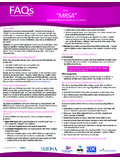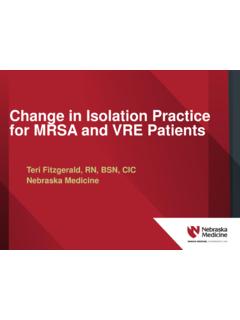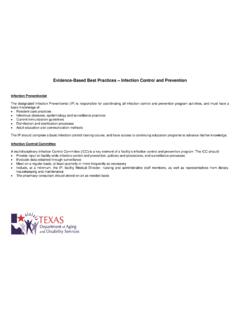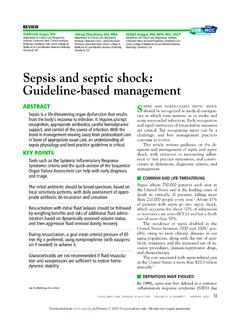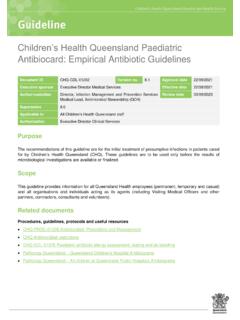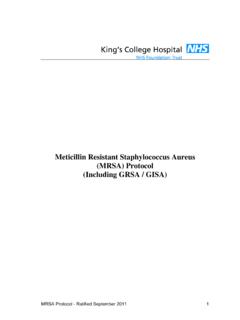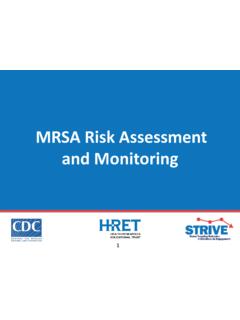Transcription of MRSA screening guidance - GOV.UK
1 Implementation of modified admission MRSA screening guidance for NHS (2014). Department of Health expert advisory committee on Antimicrobial Resistance and Healthcare Associated Infection (ARHAI). August 2014. You may re-use the text of this document (not including logos) free of charge in any format or medium, under the terms of the Open Government Licence. To view this licence, visit Crown copyright Published to , in PDF format only. 2. Implementation of modified admission MRSA screening guidance for NHS (2014). Department of Health expert advisory committee on Antimicrobial Resistance and Healthcare Associated Infection (ARHAI). Prepared by ARHAI MRSA screening Implementation Group Disclaimer The MRSA screening Implementation Group, comprising members from key professional groups, was established to determine how to give implementation guidance on MRSA screening to NHS England, in the context of recommendations from the NOW.
2 Study. The Working Group members were: Mark Wilcox (Chair, ARHAI), Peter Cowling (BIA), Brian Duerden, Carole Fry (DH), Susan Hopkins (PHE), Peter Jenks (HIS), Sally Kingsland (NHS England), and Sally Palmer (IPS). 3. Contents 4. Executive summary .. 5. Introduction .. 6. Objective .. 8. High risk specialties/units .. 8. Interventions .. 9. Compliance and audit .. 10. 11. Appendix .. 12. Annex: Consultation .. 16. 4. Executive summary The following guidance outlines a more focused, cost-effective approach to MRSA. screening . The recommendation for Trusts to move to focussed screening programmes has been designed to promote a more efficient and effective method for identifying and managing high risk MRSA positive patients.
3 Importantly, focussed screening should be adopted in line with local risk assessments to ensure that Trusts concentrate on reducing negative patient outcomes for their own populations. Changes to current practice need to be undertaken with a commitment to improved compliance with focussed screening , which should be monitored and reported to Trust Boards and commissioners. Trusts will need to regularly review (and where necessary improve) their compliance with national screening guidance for each specialty, recent MRSA infection data, patient demographics and types of services provided within individual organisations. Continued surveillance through both local and national surveillance systems will be needed to monitor the levels of MRSA.
4 Infection. The outputs of the NOW study could be used to inform policy making decisions should the prevalence of MRSA increase. 5. Introduction In the last decade there have been very marked declines in morbidity and mortality related to MRSA infection in England. Annual MRSA bacteraemia rates fell from (April 2005-March 2006) to cases per 100, 000 bed days (April 2011-March 2012).1 Significant declines have also been observed in surgical site infections (SSI) where MRSA was reported as the causative micro-organism (from 27% in 2004-6 to only 4% in 2011/12).2,3 The number of death certificates in England and Wales mentioning MRSA infection has decreased each year since 2006, when the figure peaked at 1,652; in 2012, MRSA accounted for 292 mentions of MRSA.
5 On death certificates (a 20% decrease on the previous year).4. Until April 2009, national guidance in England recommended targeted screening of patients in high risk There were no randomised controlled trials, however, to provide evidence on the most effective and cost-effective screening strategies. The Department of Health (DH) in England introduced mandatory screening of all elective and emergency admissions from April 2009 and December 2010, respectively. This decision was based on a DH impact assessment that modelled the cost-effectiveness of different screening and decolonisation strategies in preventing MRSA bacteraemias, wound infections and deaths. We note that in other settings ( Wales), where mandatory screening has not been implemented, MRSA infection rates have fallen The DH impact assessment committed to a review of this policy with additional data; thus, the NOW study was commissioned in 2011.
6 The study report underwent peer review and its findings were endorsed by ARHAI. A full report of the NOW study and a summary of its findings are ,8,9 The study showed that compliance with the current mandatory screening policy was poor ( only 61%. were screened; about half of new positives were isolated when their result became known; and about a quarter did not receive decolonisation therapy) (Appendix, Table 1). The prevalence of MRSA in new admissions was low ( overall), although this varied according to type of admission ( in emergency admissions, elective admissions and in day cases admissions) (Appendix, Tables 2 &3). These observations mean that the numbers of patients needed to be screened in order to identify one new positive were high in all admission types (emergency n=102; elective n=180; and day case n=186).
7 8. The NOW study went on to model the effectiveness and cost-effectiveness of six different screening strategies at a whole hospital level for the three categories of NHS Trust (acute, teaching and specialty) at four different levels of MRSA prevalence (the current prevalence; and twice, three and four times the current prevalence) and two levels of transmission (current and twice the estimated transmission rate). Six screening and intervention strategies were evaluated: 1) no screening (interventions applied to clinical cases only), 2) screening all admissions (emergency and elective), 3) screening all admissions to high risk specialties, 4). checklist activated screening of all admissions, 5) screening all admissions to high risk specialties plus checklist activated screening of other admissions, and 6) screening all admissions plus pre-emptive isolation of those known to be previously MRSA positive.
8 At current prevalence none of the screening strategies was likely to be cost-effective at conventional NHS levels of willingness to pay' (less than 30,000 per QALY). Costs per QALY. for routine admission screening ranged from 86,000 - 170,000, and were consistently more costly and less effective than alternatives for all hospital types. However, of the strategies involving active screening , targeting high risk specialty patients was the optimal option; mean incremental cost-effectiveness ratios (ICERs) of approximately 45,000 and 48,000 in Acute, and Teaching Trusts, respectively (Appendix, Table 4) (see below for Specialist trust results). As prevalence rose, the cost effectiveness of this strategy increased, and fell within 6.
9 Implementation of modified admission MRSA screening guidance for NHS (2014). the conventional NHS levels of willingness to pay' (Appendix, Table 4). The model results were strongly influenced by the assessment of the risk of infection, which is greater in high risk specialty patients, and has the largest impact on length of stay and mortality, the major determinants of cost and health benefits. Importantly, lack of screening of MRSA in patients admitted to low-risk specialties results in more transmission, but less proportionate risk of serious infection and death than in high risk specialties. Approximately 60% of MRSA colonised individuals will be detected by screening those known to be previously MRSA positive and high risk specialty admissions.
10 For acute and teaching trusts, the most cost effective of the screening strategies is screening high risk specialties only, at both the current prevalence and up to 4 times current prevalence (~5%). For specialist trusts, at current and twice current prevalence, again the no screening ' strategy has the greatest probability of being the most cost-effective option. However, of the active screening strategies, screening high risk specialities and performing check list activated screening of others is optimal. At higher prevalence (>3%), high risk specialty screening alone becomes the most cost effective strategy overall. However, the probability of cost-effectiveness for high risk specialty screening and high risk specialty plus checklist activated screening cluster together closely.











